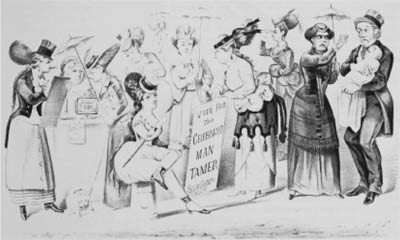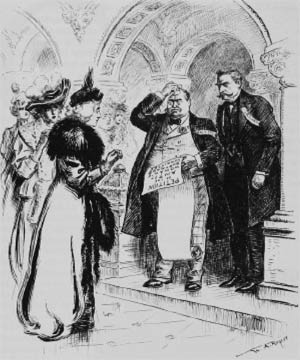by Patricia Riley Dunlap
Mocking poetry graced each issue of the The Reply. The 1913 “A Dream of Fair Women” begins:
One more unfortunate man of some note,
Rashly objected to let women vote.
So, lovely woman, this man did annoy,
Using a horse whip, nice, feminine toy.
Then a fair damsel with infinite grace,
Hurled both her shoes at the Magistrate’s face;
For she was held on a charge very small,
Taking explosives into lecture hall.
Antis weren’t shy about attacking their suffragist sisters using Cult ammunition. They argued that suffrage would create masculine women and that the “new” woman would bring about the end of civilization. “Let us read and reflect on the history of every country where women joined the shouting and the tumult. It meant always blood-shed and anarchy and a rapid degeneration of the nation. The women go farther because they are more extreme by nature and more impressionable,” cautioned the August 1912 Woman’s Protest.
In the May 1913 issue of The Reply, Helen Kendrick Johnson contemplated woman’s specialness in “The World’s Need of Women.”
Woman’s life and work, then was to be that of the world’s nourisher, its food bringer, the world’s beautifier, the world’s teacher of righteousness. What a marvelous [sic] and glorious picture! The ideal set forth in the “History of Woman Suffrage” [a six-volume work written in part by Elizabeth Cady Stanton] is the opposite of all this….
Changes in the role of women were viewed as threats to the health and survival of the state and even the species.
In the September 1912 Woman’s Protest, an article by Max G. Schlapp argued, frighteningly:
There are more criminals and imbeciles to each 1,000 of population than ever before…. When overwrought women have disturbed within themselves the process of nature, they impart a disturbance to their offspring, and, instead of the development of a normal human being, there is one distorted in body or mind or in both.
Motherhood recast as sacred duty is a unique means of exploitation. If convinced that her relevance lies solely in her ability to give birth and nurture, a woman can lose her innate sense of self. It is an old and continuing distortion that has transformed millions of women into walking fertility icons. Whether her fruitfulness is for the greater cause of State, religion, or racial supremacy, she becomes unable to satisfy even her smallest personal need without being consumed by guilt.
Moral Majority?
Woman suffrage was repeatedly linked to the detestable. “Suffrage and the Liquor Traffic” and “Suffragism and Socialism” appeared in the May 1912 and May 1913 issues of Woman’s Protest. The unnamed editor who sought to align liquor with the ballot summoned up the argument so often heard from American men that women voters would close every saloon in the land.

Articles smearing woman suffragists were common. A 1917 issue of Woman’s Protest includes articles entitled “Disloyal Even to Their Sex” and “The Real Foes of Democracy,” accusing suffragists of ignoring the war effort in favor of “un-American” demonstrations.
A favorite argument of the antis was that women’s votes would merely mimic those of their husbands, doubling the work of talliers – with no resulting change in the outcome. But from time to time, the argument went on to worry that political disagreements between husbands and wives would increase the divorce rate. This extension disturbed some antis, as it assumed wives to be capable of something other than obedience.
The antis also used a favorite tactic of proponents of minority positions: denying that the opposition holds a majority. Consider today’s anti-abortion movement’s attempts to cast itself as the voice of the “Moral Majority.” In pre-public opinion poll days, pseudo-majorities were even easier to come by. The July August 1917 Woman’s Protest suggested:
If suffragists were willing to submit to the democratic principle of the will of the majority they would be less menacing to our institutions, but the methods they employ to override the will of the people, the efforts they make to coerce the world into an acceptance of their ideas is pernicious, undemocratic and un-American.
Do As I Say, Not As I Do
Ironically, the editors and writers of the anti publications worked hard to protect women from the dangers of doing exactly what they themselves were doing – thinking, competing, organizing, and finding meaning in nondomestic ventures. Anti-suffrage women were busy founding, promoting, and sustaining organizations in at least 28 states.
| Celebrating Suffrage 1995 marks the 75th anniversary of women winning the vote. A massive parade down Pennsylvania Avenue in Washington, D.C. is planned for August 26, the day the 19th Amendment was certified as part of the U.S. Constitution. Other celebrations are planned across the country. For information and organizing kits, contact the National Women’s History Project, 7738 Bell Road, Windsor, CA 95492, (707) 838-6000. |
Ida Tarbell, the muckraking journalist who exposed the ruthlessness of Standard Oil tycoon John D. Rockefeller, was an outspoken anti-suffragist. But Tarbell’s life approximated the suffragists’ ideal. Never married, she became a nationally celebrated journalist and historian. A dogged researcher whose detailed biographies included little-known facts about her famous subjects, she authored well-received biographies of Napoleon Bonaparte and Abraham Lincoln. Yet,Tarbell saw women as frivolous, emotional creatures, and was convinced that if the suffragists succeeded, they would force women to support themselves and destroy the family as an institution. Tarbell urged suffragists to consider the long-term implications of their demands. According to her biographer, Kathleen Brady, “The specter of a revolution in women’s role unsettled her.” She was not alone.
Former first ladies Mrs. Benjamin Harrison and Mrs. Grover Cleveland, as well as Theodore Roosevelt’s sister Anna, were among the wealthy who supported the antis and their written word. While the New York and Massachusetts groups were the most consistently active, the Illinois Association Opposed to Woman Suffrage, under the leadership of wealthy Chicago matron Caroline F. Corbin, was one of the most outspoken.
This 1907 drawing pokes fun at antis. The senator holds a paper that reads: “Petition from the anti-woman’s suffrage committee.”

Echoes from the anti-suffrage past ring through American society today. Voting as an issue has been supplanted by women’s right to work outside the home for equal pay and without harassment, and to obtain safe, legal abortions, but the debate is strangely familiar, and the guilt lingers.
As before, the battlefield is a changing economy. However, unlike the steel and railroad economy of the Industrial Revolution, the Communication Age requires mental, not physical strength. Birth control and modern appliances give most families homes that no longer need constant attention. All the signs point to woman’s final liberation, yet the appeal and guilt of the Cult of True Womanhood, exposed and restricted as it may be, remains.
Marilyn Quayle, a lawyer herself, evoked The Cult of True Womanhood in a speech at the 1992 Republican Convention when she stated, “Most women do not wish to be liberated from their essential natures as women.”
Phyllis Schlafly, the “Sweetheart of the Silent Majority” whose determination helped defeat the Equal Rights Amendment in 1982, is a throwback to her anti-suffrage predecessors. Schlafly, who now heads the Eagle Forum, which promotes school prayer and anti-abortion and anti-homosexual legislation, insists that “women would rather be loved than liberated.” Since the early 1970s she has headed up an organized attempt to deny other women the right to the type of fulfillment she herself has enjoyed as a lobbyist, radio commentator, fund-raiser, and syndicated columnist.
What makes these women tick? Sociologist Jean Howard recognized anti-suffragists as privileged wives unable to “identify with women beyond their own class.” Without empathy, privilege generates emotional isolation. Anti-suffragists were more interested in protecting their comfort than in helping the less fortunate. They considered women who were poor, foreign-born, or black ignorant savages unworthy of the attention of ladies.
Marilyn Quayle exposed her own isolation in a 1992 interview for Woman’s Day when she assured readers that she was merely a “homemaker” who, though she never cooks, “plans menus and works with the house staff to ferret out bargains….” Schlafly’s isolation comes packaged in anti-feminist guilt since, in her words, sexual harassment is no problem for the “virtuous woman except in the rarest of cases.” Paraphrasing the anti-suffragists, Schlafly believes: good women won’t be harassed; bad women will.
Patricia Riley Dunlap is a Virginia historian who teaches American and women’s history at Northern Virginia Community College and Germanna Community College. She has written a book on American frontier women.
